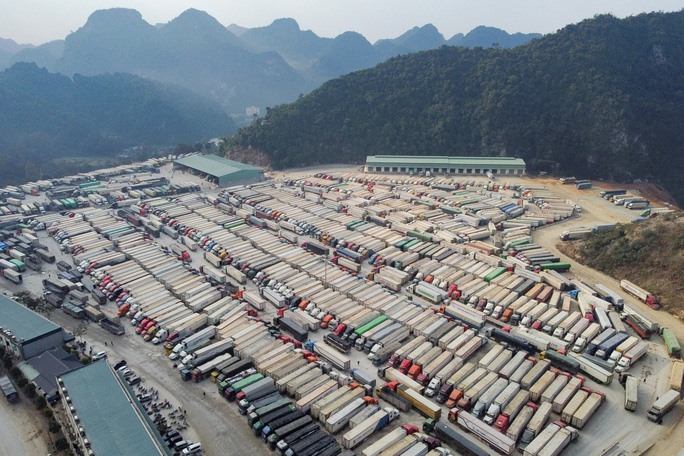
Trucks wait at nothern border gate. — Photo chinhphu.vn
HÀ NỘI — Volatile consumption is often an issue for Vietnamese fruit sales during the first three months of the year. Standardisation is the only solution to this problem, according to Nguyễn Quốc Toản, director of the Agro-Processing and Market Development Department.
Toản said standardisation required changes in agro-processing, and management zones, quality control, and origin tracking needed to be put in place, and every fruit given a certificate of origin.
An “ecosystem” that helps agricultural produce reach consumers should be set-up as well to link production with consumption. Associations, producers, logistic firms and relevant units are recommended to cooperate in market planning to ensure crops sell well once harvested.
The director also called for closer links between actors in the value chain, notably farmers and authorities, and the replication of successful business models such as Đồng Giao and Nafoods in localities.
The recent trade bottleneck at border gates has taken a heavy toll on firms and farmers, and it is not the first time Vietnamese fruits are vulnerable to trade uncertainty.
If standardisation is imposed across the board, trade bottlenecks would become a thing of the past as goods stuck at the border could be transported to factories to be processed, Toản added.
At a webinar on Thursday, Nguyễn Lâm Viên, general director of Vinamit JSC, said that official channels were the key to sustainable trade, but many firms still exported their goods unofficially on grounds of tax.
“A value-added tax of 7 per cent applies to goods exported via official channels, meanwhile no tax is levied on goods via unofficial channels,” Viên said.
Viên recommended local authorities establish information centers within agricultural zones to better communicate with the Chinese market. These centers would gather information on the market and send it to agricultural zones to keep production in line with market demand.
Firms are also advised to shift their focus to processed goods to expand their global footprint and become less dependent on fresh exports.
Regarding agro-processing, Toản noted that the Government and firms had shown interest in processing technology for many years. Between 2018 and 2020, up to 70 processing complexes were built with a total investment of US$20 billion.
“In 2019, raw exports took up 90 per cent of total exports. Meanwhile, processed exports made up 30 per cent in 2020-2021. That was a step forward,” Toàn added.
The director believes there is still plenty of room for improvement because Việt Nam produces about 28 million tonnes of fruit and vegetable a year whereas just 30 per cent of such produce is processed currently.
Trần Thanh Hải, deputy director of the Import-Export Department, revealed that most Vietnamese agricultural exports entered China on road via Quảng Ninh, Lạng Sơn and Lào Cai provinces.
Road transportation allows trucks to carry agricultural produce straight from farms to the border and is suitable for exports in small volumes. However, this means of transport often leads to trade bottlenecks at harvest time.
Accordingly, some firms had to turn to maritime transportation to maintain their trade flow. Notably, around 1,400 refrigerated containers were shipped from HCM City to China in November 2021. In December the figure rose to more than 4,000.
The downside of exporting by sea is that it requires refrigerated containers to deliver agricultural produce. Meanwhile, dry imports from China are carried in ordinary containers. Such a disparity sometimes results in a refrigerated container shortage.
It is also worth noting that refrigerated containers need onboard power sockets to operate. When exports come in large volumes, the number of sockets may be insufficient to support the number of containers, creating a setback to maritime trade.
Another good alternative to road is rail transportation. Since February 2020, the cross-border railway Đồng Đăng Station-Bằng Tường Station has transported an average of 100 refrigerated containers per month from Việt Nam to China, or up to 200 on some occasion.
Regardless of the mode of transport, Vietnamese exports must comply with various Chinese regulations on food safety, phytosanitary, origin tracking and packaging before crossing the border, Hải added.
Nguyễn Mạnh Hùng, chairman of Nafoods JSC, urged MARD and authorities to allocate more budget on trade promotion to help Vietnamese produce gain grounds in the international market. He was concerned that Thailand, Japan and China are doing better than Việt Nam in such areas.
Vietnamese firms are also called on to work together to arrive at a consensus on price and not set prices individually to the detriment of supply chains.
“Nafoods and Đồng Giao sell condensed passion fruit for VNĐ4,500. All of sudden, a small firm emerges and sells for VNĐ4,000. This firm’s output is not our concern as it is almost next to nothing. Unfortunately, customers rely on that low price to bargain down our products. In turn, we have no choice but continue to buy produce at lower prices,” the chairman said. — VnExpress News
- Reduce Hair Loss with PURA D’OR Gold Label Shampoo
- Castor Oil Has Made a “Huge” Difference With Hair and Brow Growth
- Excessive hair loss in men: Signs of illness that cannot be subjective
- Dịch Vụ SEO Website ở Los Angeles, CA: đưa trang web doanh nghiệp bạn lên top Google
- Nails Salon Sierra Madre
 VnExpress News The News Gateway of Vietnam
VnExpress News The News Gateway of Vietnam




